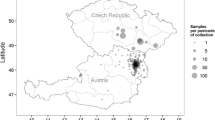Abstract
Rivers may serve as reservoirs for enteric organisms. Very little is known about the boundaries of microbial communities in moving bodies of water so this study was undertaken to find the limits of distribution of some bacteria, focusing on enteric organisms. The presence of Salmonella, Campylobacter, and Enterococcus spp. and the antimicrobial resistance phenotypes carried by these organisms was evaluated for the Upper Oconee River basin, a small river in the lower Piedmont of northeastern Georgia, USA. Samples were obtained from 83 sites during a 3-h period on a spring day (April 2005) in an approximately 30 × 20 km region. Campylobacter spp. was isolated at 12 sites. The Campylobacter isolates from three sites were resistant to tetracycline. Of the five short-variable region (SVR) subtypes of Campylobacter that were found, three were found at more than one site, two types were found twice, and one subtype was found three times. Enterococcus was isolated at 71 sites. E. casseliflavus was the most common species. Based on species identification and antimicrobial resistance patterns, 24 types of Enterococcus were found. Salmonella was isolated from 62 sites. Of the 19 Salmonella serovars that were isolated, serovar Muenchen accounted for about 20% of the isolates. The next three most common serovars isolated, Rubislaw, Hartford, and Give, accounted for about 44% of the river isolates. Antimicrobial resistance profiling offered limited differentiation of Salmonella isolates because only seven isolates were resistant to any antimicrobial. The sites at which Salmonella, Campylobacter, or Enterococcus were isolated did not correlate with each other or with the total coliform number or Escherichia coli count for the site. However, isolates of some of the same species and type occurred in clusters that were restricted to areas within 5 to 6 km.



Similar content being viewed by others
References
Clesceri LS, Greenberg AE, Eaton AD (1998) Standard methods for the examination of water and wastewater, 20th edn. APHA, AWWA, WEF, Washington, DC
Coyne MS, Blevins RL (1995) In: Steele K (ed) Animal water and land-water interface. Lewis Publishers, pp 77–87
Davison J (1999) Plasmid 42:73–91
Dargatz DA, Fedorka-Cray PJ, Ladely SR, Kopral CA, Ferris KE, Headrick ML (2003) J Appl Microbiol 95:753–761
Dean DM, Foran ME (1992) J Soil Water Conserv 47:368–369
Edwards DR, Daniels TC (1992) Bioresour Technol 33:9–33
Englen MD, Fedorka-Cray PJ (2002) Lett Appl Microbiol 35:353–356
Geohring LD, Wright PE, Steenhuis TS (1998) In: Brown L (ed) Drainage in the 21st century: food production and the environment. ASAE Publication No. 02-98, ASAE, St. Joseph, MI, pp 1–8
George BA, Fagerber DJ (1984) Am J Vet Res 45:2336–2341
Giddens J, Barnett AP (1980) J Environ Qual 9:518–520
Howell JM, Coyne MS, Cornelius PL (1995) J Environ Qual 24:411–419
Hunter PR (2003) J Appl Microbiol 94:37S–46S
Jackson CR, Fedorka-Cray PJ, Barrett JB (2004) J Clin Microbiol 42:3558–3565
Koenraad PMF, Rombouts FM, Notermans SHW (1997) Water Environ Res 69:52–63
Meinersmann RJ, Helsel LO, Fields PI, Hiett KL (1997) J Clin Microbiol 35:2810–2814
Meinersmann RJ, Phillips RW, Hiett KL, Fedorka-Cray P (2005) Appl Environ Microbiol 71:6368–6374
Morris CE, Bardin M, Berge O, Frey-Klett P, Fromin N, Girardin H, Guinebretière M-H, Lebaron P, Thiéry JM, Troussellier M (2002) Microbiol Mol Biol Rev 66:592–616
NCCLS (2002) Performance standards for antimicrobial disk and dilution susceptibility tests for bacteria isolated from animals. Wayne, PA
NCCLS (2003) Methods for dilution antimicrobial susceptibility tests for bacteria that grow aerobically. Wayne, PA
Ng E, Wilkins R, Perras A (1993) How far is it to the nearest hospital facility? Calculating distances using the Statistics Canada Postal Code Conversion File. Health Reports (Statistics Canada, Catalogue 82-003) vol. 5, pp 179–188
Oda Y, Wanders W, Huisman LA, Meijer WG, Gottschal JC, Forney LJ (2002) Appl Environ Microbiol 68:3467–3477
Riedl S, Ohlsen K, Werner G, Witte W, Hacker J (2000) Antimicrob Agents Chemother 44:3189–3192
Sarkar S (2006) In: Edward N. Zalta (ed) “Ecology”, The Stanford Encyclopedia of Philosophy (Spring 2006 Edition), URL = <http://plato.stanford.edu/archives/spr2006/entries/ecology/>
Sikorski J, Nevo E (2005) Proc Natl Acad Sci USA 102:15924–15929
Skelly C, Weinstein P (2003) Environ Health Perspect 111:19–28
Stern NJ, Wojton B, Kwiatek K (1992) J Food Prot 55:514–517
Vail JH, Morgan R, Merino CR, Gonzales F, Miller R, Ram JL (2003) J Environ Qual 32:368–373
Vandamme P, Pot B, Gillis M, de Vos P, Kersters K, Swings J (1996) Microbiol Rev 60:407–438
Walker SE, Mostaghimi S, Dillaha TA, Woest FE (1990) ASAE Trans 33:807
Wang G, Clark CG, Taylor TM, Pucknell C, Barton C, Price L, Woodward DL, Rodgers FG (2002) J Clin Microbiol 40:4744–4747
Acknowledgments
The authors are grateful to the volunteers of the Upper Oconee Watershed Network (UOWN) for their help in the collection of water samples. Mention of trade names or commercial products in this publication is solely for the purpose of providing specific information and does not imply recommendation or endorsement by the U.S. Department of Agriculture.
Author information
Authors and Affiliations
Corresponding author
Rights and permissions
About this article
Cite this article
Meinersmann, R.J., Berrang, M.E., Jackson, C.R. et al. Salmonella, Campylobacter and Enterococcus spp.: Their Antimicrobial Resistance Profiles and their Spatial Relationships in a Synoptic Study of the Upper Oconee River Basin. Microb Ecol 55, 444–452 (2008). https://doi.org/10.1007/s00248-007-9290-6
Received:
Revised:
Accepted:
Published:
Issue Date:
DOI: https://doi.org/10.1007/s00248-007-9290-6




